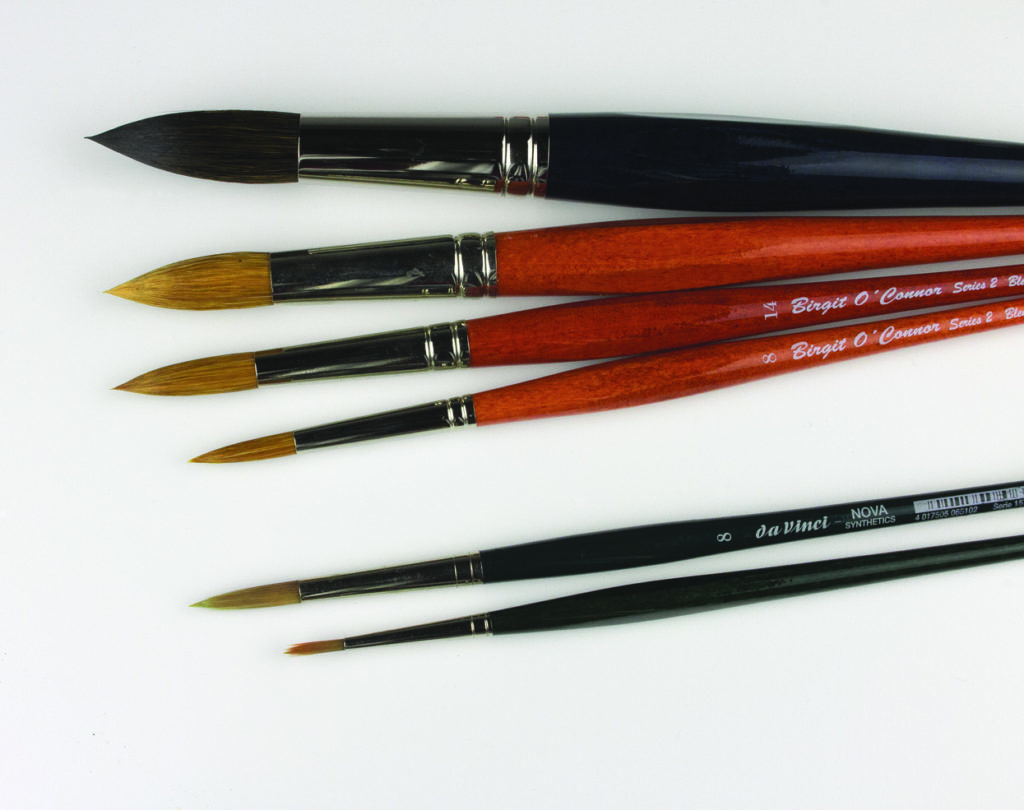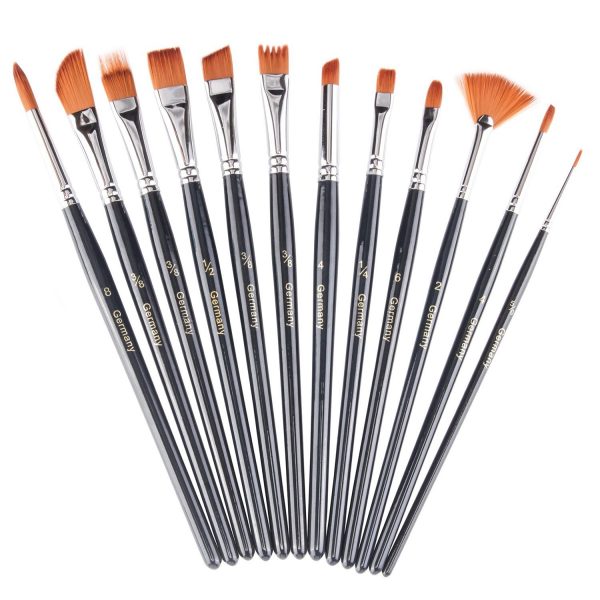
If you're buying your first paintbrushes for watercolors, I'd recommend three round brushes: small (around size 3), medium (5-6), and large (12). Because of their versatility, they'll be all you need in the beginning. In fact, you could paint an entire painting with.
Having a sound knowledge about the types of watercolor brushes will help you master the medium with ease. The process is particularly responsive to the excellence of the brushes used. It is also too receptive to conceal any flaws in the tools used. All the premium watercolor paints and all the classiest papers cannot reimburse for a watercolor brush that does not carry out well. Hence it is must to select a quality brush for watercolor painting.


These brushes perform finest when they are drenched in water for at least five to ten minutes previous to they are used. Wetting a watercolor brush initially allows for the eviction of all air bubbles, which can make stripes in the applied color, and allows the brush hairs to soften and come into an appropriate shape. To take the maximum probable benefit of a brush, it must be held as vertical to the working platform as can be managed.
- In today's video we are going to talk about all the common / different types and shapes of watercolor brushes, their uses and how to actually choos.
- All the best Types Of Watercolor Brushes 29+ collected on this page. Feel free to explore, study and enjoy paintings with PaintingValley.com.
Types Of Watercolor Brushes
A method has evolved over the years to reimburse for imperfectly made or badly damaged brushes. It includes holding a brush at a 45-degree angle to the working platform and gradually slanting the brush as the tip is drawn across the paper to create a constantly drawn line. A well-made brush held at the suitable 90-degree angle produces this result with little talent and attempt.
Selecting the watercolor brush for your painting is often a tough decision for beginners in this platform. Being a tough medium, it is imperative to understand the usage pattern of each brush type to work well with this medium. On the basis of the material used to craft the brush, we can categorize it into two:
• Natural hair brush
• Synthetic brush
The natural or sable brushes are good to work with. But there are synthetic alternatives with high quality. They are numbered on the basis of quantity of hair and length. It is often better to work with medium brushes. The brushes with small numbers can be used to spice up the details.
If shape is the major criteria, we can classify brushes in different ways. The most widely used type is round brush. Flat head, rigger, mop, Chinese, fan etc are the other types. It would be enough if you buy only some of the selected types for your painting.
Testing is of key significance when purchasing a brush. Whenever probable you must check, or at least methodically examine, a brush previous to you acquire it. The following are a few ways of examination.
Most of the brushes come with starch in the hairs to guard them until use. The stiff tip has to be relaxed to check it. This may be completed by lightly undulating the starched brush tip stuck between two fingers. After you have finished this, the single hairs can be extended out by tenderly pressing the hairs close to the ferrule to fan them out for examination. Now you can look for regularity in length and appearance. There should be no dull ends and the tips must not have been slashed or trimmed in any manner

The hairs must be congregated firmly so that there is a sense of fullness when the hairs are strained jointly near the end where they go into the ferrule.
When you buy watercolor brush, make sure that you purchase the best quality materials at the best price.
These free charts describe the different brush shapes and hair types, and Blick's system of standard brush sizing and measurement. |
|
|
|
DESCRIPTION AND USAGE Flat ferrule, short-length hairs, set with longer hairs at one end. Useful for precise strokes, and for lines and curves, with thick or heavy color. |
| MEDIA watercolor
acrylic
decorative |
| |
DESCRIPTION AND USAGEFlat ferrule, short-length hairs, usually set in a long handle. Width and length of brush head is about equal. Useful for short, controlled strokes, and with thick or heavy color. |
| MEDIAoil
acrylic
decorative |
| FIBERsable mongoose
bristle
badger
synthetic |
|
DESCRIPTION AND USAGEFlat ferrule, spread hairs. Natural hair is more suitable for soft blending, and synthetic works well for textural effects. Useful for smoothing and blending, special effects and textures. |
| MEDIAoil
acrylic
decorative |
| FIBER bristle
badger
synthetic |
|
DESCRIPTION AND USAGEThick, flat ferrule and oval-shaped medium to long hairs. Long handles. Natural hair is more suitable for blending because the hairs hold together when wet. With its soft rounded edges, the filbert is suitable for blending and figurative work. |
| MEDIAoil
acrylic
decorative |
| FIBER sable
mongoose
bristle
badger
synthetic |
|
DESCRIPTION AND USAGE Flat ferrule, square-ended, with medium to long hairs. Provides lots of color capacity and easy maneuverability. Use for bold, sweeping strokes, or on edge for fine lines. Use heavier filling for heavier paint. |
| | FIBER sable
mongoose
bristle
badger
synthetic |
|
DESCRIPTION AND USAGE A hake brush is an oriental-style wash brush on a long flat handle. It is useful for laying in large areas of water or color, for wetting the surface, and for absorbing excess media. |
| | FIBER squirrel
goat
ox
bristle
synthetic |
|
DESCRIPTION AND USAGE Also known as an outliner. Round ferrule, square-ended brush, with extra-long hairs and a short handle. Large color carrying capacity. Useful for delicate lettering, outlining, and long continuous strokes. |
| | FIBER sable
squirrel
synthetic |
|
DESCRIPTION AND USAGE A mop is a round, full version of the wash brush, made of soft, absorbent natural hair. It is useful for laying in large areas of water or color, for wetting the surface, and for absorbing excess media. |
| | |
DESCRIPTION AND USAGE Flat ferrule, square-ended medium to long length hairs. Short handles. Large color carrying capacity. Useful for painting block letters in a single stroke. |
| MEDIA oil
ink
decorative
sign paint |
| FIBER sable
squirrel
ox
synthetic |
|
DESCRIPTION AND USAGE Wash brushes come in varied shapes. The oval wash has rounded hairs, flat ferrules, and produces a soft edge, with no point. A wash brush is useful for laying in large areas of water or color, for wetting the surface, and for absorbing excess media. |
| | FIBER squirrel
ox
bristle
synthetic |
|
DESCRIPTION AND USAGE Plastic or natural quill ferrule, with a permanent or detachable handle. Long hairs, and a natural-shaped tip. The writer has a round ferrule and a short handle. Useful for lettering and poster work. Good on smooth surfaces such as glass. |
| | |
DESCRIPTION AND USAGE Round ferrule, round or pointed tip. Useful for detail, wash, fills, and thin to thick lines. A pointed round is used for fine detail. A detailer is a pointed round with very short hair. |
| | |
DESCRIPTION AND USAGE The long handles and tapered bristles are perfect for detailed work on large paintings. Also good for delicate decorative painting. |
| MEDIA oil
acrylic
decorative |
| |
DESCRIPTION AND USAGE Pointed, narrow brush with very long hair. Liners are shorter and narrower. Short handles, round ferrules. Large color carrying capacity. Useful for delicate lettering, highlighting, outlining, and long continuous strokes. |
| MEDIA watercolor
decorative
ink
sign paint |
| |
DESCRIPTION AND USAGE Wash brushes come in varied shapes. The square wash can produce varying shapes and widths, and often has a short, 'flat-footed' handle for scraping, burnishing, and separating watercolor paper from blocks. A wash brush is useful for laying in large areas of water or color, for wetting the surface, and for absorbing excess media. |
| | FIBER squirrel
ox
bristle
synthetic |
|
Types Of Paint Brushes For Watercolor Painting




